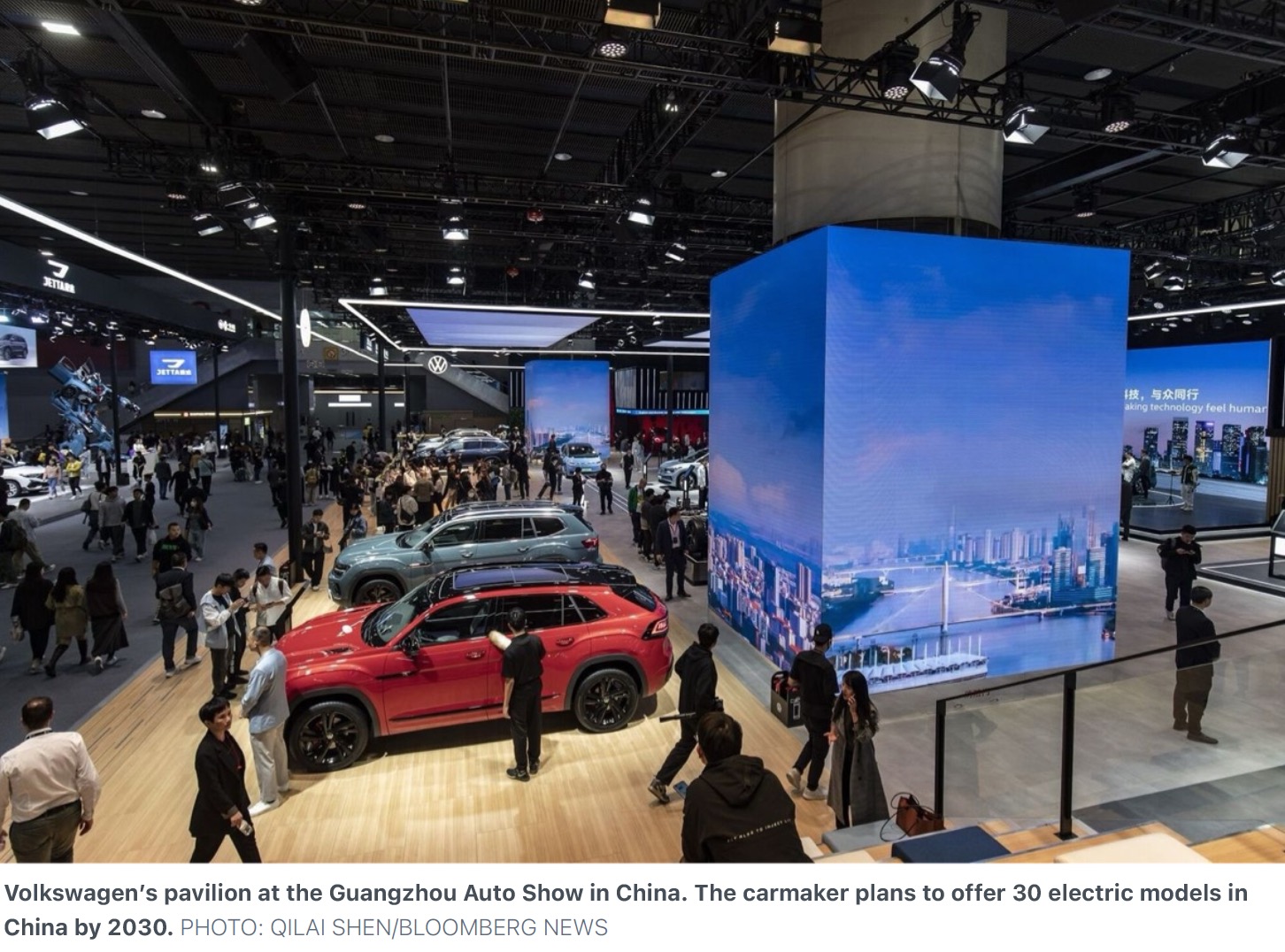Will Chinese Automakers Dominate The Global Market?

Table of Contents
The global automotive industry is in the midst of a seismic shift. While established players from Europe, America, and Japan have long held sway, a new force is rapidly rising: Chinese automakers. Fueled by significant technological innovation, substantial government support, and a relentless focus on electric vehicles (EVs), these companies are posing a serious challenge to the global automotive market’s status quo. This raises a critical question: will Chinese automakers truly dominate the global car market, or will established brands maintain their grip? This article delves into the factors driving the rise of Chinese automakers, the challenges they face, and the potential implications for the future of the automotive industry. We'll examine their strengths, weaknesses, and the likelihood of achieving global market dominance.
<h2>The Rise of Chinese Automakers: Technological Innovation and Government Support</h2>
The meteoric ascent of Chinese automakers isn't accidental; it's a result of a strategic combination of technological advancements and significant government backing.
<h3>Technological Advancements</h3>
Chinese companies have made impressive strides in several key areas of automotive technology, particularly in the burgeoning electric vehicle sector.
-
Electric Vehicles (EVs) and Battery Technology: Chinese manufacturers are leading the charge in EV technology, particularly in battery production. Companies like CATL are global leaders in battery technology, offering superior energy density and longer lifespans at competitive prices. This technological advantage is a cornerstone of their success in the global EV market.
-
Autonomous Driving Capabilities: Significant investment in research and development (R&D) is driving rapid advancements in autonomous driving features. Chinese automakers are rapidly integrating cutting-edge sensor technology, AI algorithms, and sophisticated software to develop self-driving capabilities, competing head-to-head with established players.
-
Investment in Research and Development (R&D): The Chinese government's emphasis on technological self-reliance has fueled substantial investment in R&D within the automotive sector. This commitment to innovation allows Chinese companies to quickly adapt to evolving market trends and technological advancements.
-
Bullet Points:
- Superior battery technology from companies like CATL.
- Competitive pricing in EVs, making them attractive to a wider consumer base.
- Rapid development in autonomous driving features, closing the gap on global leaders.
- Government subsidies significantly boosting R&D efforts.
<h3>Government Initiatives and Subsidies</h3>
The Chinese government has played a pivotal role in nurturing the growth of its domestic auto industry.
-
Government Subsidies for EV Production and Purchase: Generous subsidies have stimulated both the production and adoption of electric vehicles within China, creating a large domestic market and providing valuable experience for global expansion.
-
Infrastructure Investments Supporting EV Charging Networks: Massive investments in charging infrastructure are crucial for widespread EV adoption. China’s extensive network of charging stations is a significant advantage.
-
Export Incentives to Penetrate International Markets: The government actively supports the export of Chinese vehicles through various incentives, helping them gain a foothold in international markets.
-
Favorable Policies for Domestic EV Manufacturers: Policies favoring domestic EV manufacturers, including preferential treatment in procurement and licensing, create a competitive advantage.
-
Bullet Points:
- Government subsidies incentivize EV production and consumer purchases.
- Significant investment in charging infrastructure facilitates widespread EV adoption.
- Export incentives actively support global market penetration.
- Favorable policies create a supportive environment for domestic manufacturers.
<h2>Competitive Advantages and Challenges for Chinese Automakers</h2>
While Chinese automakers boast several competitive advantages, they also face significant challenges in their quest for global dominance.
<h3>Competitive Pricing and Cost-Effectiveness</h3>
One of the key strengths of Chinese automakers is their cost-effectiveness.
-
Lower Manufacturing Costs: Lower labor costs and efficient supply chains contribute to significantly lower manufacturing costs compared to Western competitors.
-
Efficient Supply Chains: Well-established and efficient supply chains allow for greater economies of scale and faster production times.
-
Competitive Pricing Strategies: This cost advantage translates into competitive pricing strategies that attract price-sensitive consumers globally.
-
Bullet Points:
- Lower manufacturing costs due to lower labor costs and efficient supply chains.
- Ability to offer competitive pricing, attracting price-conscious consumers.
- Efficient supply chain management enables faster production and lower overall costs.
<h3>Challenges: Brand Perception and Global Expansion</h3>
Despite their technological prowess and cost advantages, Chinese automakers face hurdles in building global brand recognition and navigating international markets.
-
Overcoming Negative Brand Perceptions: In some markets, overcoming pre-existing perceptions about the quality and reliability of Chinese products remains a significant challenge.
-
Navigating Complex International Regulations and Standards: Meeting diverse international regulations and safety standards is a complex undertaking, requiring substantial investment and expertise.
-
Building Robust Global Distribution Networks: Establishing efficient and widespread distribution networks in foreign markets is essential for global expansion but presents logistical and financial challenges.
-
Managing Supply Chain Disruptions and Geopolitical Risks: Global supply chain disruptions and geopolitical risks pose significant challenges to consistent production and market access.
-
Bullet Points:
- Building strong brand recognition and trust in international markets.
- Adapting to diverse international regulations and safety standards.
- Establishing efficient global distribution networks.
- Mitigating the risks associated with global supply chain disruptions and geopolitical factors.
<h2>Impact on the Global Automotive Landscape</h2>
The rise of Chinese automakers is already reshaping the global automotive landscape, with far-reaching implications.
<h3>Market Share and Competition</h3>
Chinese automakers are steadily increasing their global market share, putting pressure on established players.
-
Growing Market Share of Chinese EV Brands Globally: Chinese EV brands are rapidly expanding their presence in global markets, capturing significant market share.
-
Increased Pressure on Established Automotive Manufacturers: This increased competition is forcing established manufacturers to innovate and adapt more quickly.
-
Potential for Strategic Alliances and Mergers: We may see increased strategic alliances and mergers between Chinese and international companies in the coming years.
-
Bullet Points:
- Increasing market share of Chinese EV brands globally.
- Increased pressure on established automotive manufacturers to compete.
- Potential for strategic alliances and mergers between Chinese and international companies.
<h3>Future of the Global Automotive Industry</h3>
The long-term impact of Chinese automakers' growth will be profound.
-
Shift in Global Automotive Manufacturing Hubs: A gradual shift in global automotive manufacturing hubs towards Asia is likely.
-
Accelerated Technological Advancements in the Automotive Sector: Increased competition will drive accelerated technological advancements across the industry.
-
Potential Impact on Jobs in Traditional Automotive Manufacturing Centers: This shift could lead to job displacement in traditional automotive manufacturing centers.
-
Increased Global Competition and Innovation: Increased competition will drive innovation and offer consumers greater choice and more competitive pricing.
-
Bullet Points:
- Potential shift of global automotive manufacturing hubs towards Asia.
- Accelerated technological innovation within the automotive sector.
- Potential job displacement in established automotive manufacturing regions.
- Increased global competition fostering innovation and consumer benefits.
<h2>Conclusion</h2>
The rise of Chinese automakers is undeniable. Their technological advancements, particularly in the electric vehicle sector, coupled with significant government support, have created a formidable force in the global automotive industry. While complete dominance isn’t guaranteed, their rapid growth presents a significant challenge to established players. The factors discussed – technological innovation, government support, competitive advantages, and the challenges they face – paint a complex picture. Further research and analysis are needed to fully understand the long-term impact of this evolving landscape. Stay informed on the latest developments regarding Chinese automakers and their impact on the global automotive market. Understanding the future of this dynamic industry requires continuous monitoring of these key players and their strategies.

Featured Posts
-
 Cnn Anchor Reveals His Go To Florida Getaway
Apr 26, 2025
Cnn Anchor Reveals His Go To Florida Getaway
Apr 26, 2025 -
 Increased Us Port Fees Auto Carrier Anticipates 70 Million In Losses
Apr 26, 2025
Increased Us Port Fees Auto Carrier Anticipates 70 Million In Losses
Apr 26, 2025 -
 Should You Return To A Company That Laid You Off A Practical Guide
Apr 26, 2025
Should You Return To A Company That Laid You Off A Practical Guide
Apr 26, 2025 -
 Explore Orlandos Culinary Scene 7 New Restaurants For 2025
Apr 26, 2025
Explore Orlandos Culinary Scene 7 New Restaurants For 2025
Apr 26, 2025 -
 Transatlantic Ai Divide Trump Administration Vs European Regulations
Apr 26, 2025
Transatlantic Ai Divide Trump Administration Vs European Regulations
Apr 26, 2025
